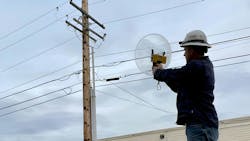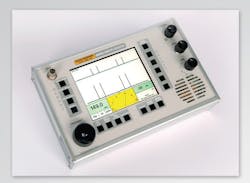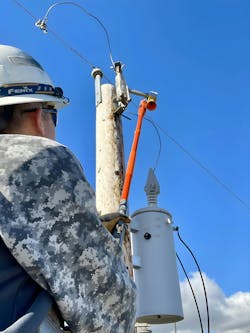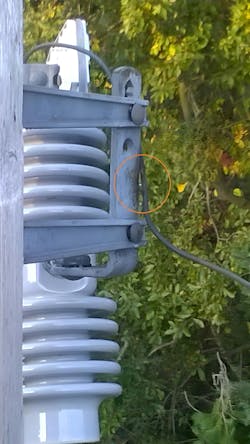Imagine yourself driving home from work on a nice summer evening. You put in a few hours of overtime, and the sun is just starting to sink low on the horizon. You have that satisfied feeling after finishing a long day on the job, and the local baseball team is on the radio. It’s the bottom of the ninth inning, your team is down by a run, and they just moved a runner to third. With two outs, your favorite player steps up to the plate. What better way to end the day than listening to your team rally for a comeback win?
Just as the pitcher winds up to deliver the ball, your radio signal is overcome by the ear-splitting crackle of radio static. Stuck at a red light, all you can do is wait and listen to the popping white noise. Finally, the light turns green, and as you drive ahead down the road that annoying crackle continues for a half mile before the fading static is replaced by the familiar voice of your team’s announcer. “Well fans, it was a heck of a game tonight, and I can’t believe what we all just witnessed! I’m not sure such an exciting ending has ever occurred on a baseball diamond in my career!” The feeling of satisfaction that your team won is somehow drowned out by the disappointment that you missed the critical moment. All because of that darned crackling radio static. Radio frequency interference (RFI) has struck again.
RFI is “the effect of unwanted energy due to one or a combination of emissions, radiations or inductions upon reception in a radiocommunication system, manifested by any performance degradation, misinterpretation or loss of information which could be extracted in the absence of such unwanted energy,” according to Radio Interference. In other words, something in the atmosphere caused by an energy source interferes with clear radio transmission.
Many different things can contribute to RFI, but perhaps the most common occurrence is found on overhead power lines. As power line workers, many of us may remember a sentence or two from our apprenticeship that reminded us about the importance of bending over the tails of our tie-wires to prevent leaving an air gap and eliminate RFI or TVI.
Beyond that information, most lineworkers don’t get much education about or exposure to RFI. However, power companies do have a legal responsibility to respond to RFI issues caused by their system, investigate and find a solution, as directed by the FCC eCFR 47 CFR 15.5 -- General conditions of operation. If these RFI investigations are done improperly, the results can be wasted time and money and ultimately, an unresolved issue that could escalate.
Identifying Sources of RFI
The sources of RFI on and around power lines are often not what lineworkers would expect. Power line RFI is a very specific occurrence. Simply put, it is created when two conductive surfaces or objects of a different potential become close enough (but not touching) for an arc to jump across that gap. Sometimes these conductive surfaces may even appear to be touching but are actually separated by only corrosion.
Because of the nature of an AC sine wave, and the constantly oscillating voltage 60 times per second, this arcing usually occurs at a very rapid pace, when the voltage required is high enough during each cycle. The spark then extinguishes and reignites repeatedly. This constant, but predictable pattern, creates a signature sound that the trained ear can often identify as RFI on the radio.
Because of what they learned during their apprenticeship, lineworkers tend to look at tie wires for RFI. Beyond that, it is natural to look for loose hot taps, failing secondary connections, transformers or cracked or dirty insulators. Though these can be RFI sources, they are rarely the culprits.
Instead, guy wires, loose hardware, ground wires and dead ends are often repeat offenders. Without proper training and locating tools designed specifically for power line RFI, it is almost impossible to accurately identify the precise cause of the radio interference. An RFI investigator might get lucky and narrow a search down to the offending pole, but if the exact point of the arcing isn’t known, it’s possible that too much line work will be done in attempt at resolution. Although this may end up temporarily solving the customer’s complaint, it leads to poor work practices by setting a standard for unnecessarily replacing too much equipment, which results in wasted time, money and effort. This approach may also expose lineworkers to more hazards than necessary, by working on or around energized equipment when it isn’t needed.
Getting Trained on RFI Troubleshooting
As a first response troubleman for my employer, I respond to all types of power outages, electrical emergencies, public safety concerns, customer needs and more. At one point, I was offered the opportunity to add the task of RFI responder for my area, and I accepted. I was given a few foreign-looking tools, some old paperwork and a brief lesson from a senior co-worker who previously had this duty.
I trudged along, responding to the occasional RFI complaint with limited success. At one point, I looked through the old paperwork I was given and found the contact information for Mike Martin from RFI Services. He has been working on RFI locating and troubleshooting for more than 40 years, and he has found that the need for his services have continued to grow every year. He was also the RFI training and locating expert on the IEEE committee that spent five years writing the IEEE’s RFI Power Line Interference
Standard for Power Companies
After visiting Mike’s website, I discovered he was offering an RFI training and troubleshooting workshop later that year. Gaining approval from my supervisor, I made arrangements to attend the workshop, which was a game changer in my RFI learning process.
Mike is a pioneer in the field of power line specific RFI investigation and has worked for decades on this specific issue. His two-day workshop provides a combination of classroom information and hands-on field work. After completing the training, I was eager to get back and put the lessons to work.
Leveraging Best Practices
As the years have progressed, I’ve continued responding to customers’ RFI complaints. Some have been more difficult than others, but with time and dedication, I’ve been able to find the source of the interference in most cases.
I’ve learned the importance of initially having a conversation with the customer to find out the specific details of their complaint and observe the specific characteristics of the interference. After that, I follow a specific troubleshooting process to eliminate any possible RFI sources within the customer’s own home (which I have found to be the case on multiple occasions).
If the investigation moves outside the building and onto the overhead lines, I then use a set of RFI specific tools in the troubleshooting process. The search begins broadly, by driving out the nearby area, while observing and listening to the feedback from a receiver attached to a truck-mounted antenna. That allows me to narrow the search to one or two poles or structures.
Once there, I continue on foot with another device that allows me to scan each pole from top to bottom, quickly analyzing every tie wire, insulator, nut, bolt, connector, etc., until I find a smoking gun. The final step in the process is to go up in the bucket with one last RFI tool to get an absolute up-close verification of the source of the RFI.
One great advantage I have in my current position is that I am a journeyman lineworker and a trained RFI field investigator. This enables me to not only identify the source of the interference, but also to mitigate that noise source in many cases. If the scope of work requires multiple lineworkers or a full crew for safety or operational purposes, then I have direct access to initiating that process. There have been many times that I have responded to a customer’s RFI complaint, met with them onsite, tracked down the noise source and eliminated the RFI all in one trip. This is as efficient as it gets, and as lineworkers we all strive for safety and efficiency.
As a lineworker, RFI investigation has been an interesting experience in my career. I believe we all continue to learn, grow and improve as electrical workers, and this nuanced branch of line work has given me a constant opportunity to evolve. Finding the right resources and people is a key factor in successfully building our skills as lineworkers.
Editor’s Note: To learn more about Jon Backman and his passion for training others in the line trade, listen to a new episode of the Line Life Podcast at linelife.podbean.com.
Seven Steps to Investigating RFI Location
When approaching RFI investigation, it is imperative to follow some specific steps.
-
Get trained. Since RFI location is a specialized task, specialized training is a must.
-
Always contact the complainant first. If possible, meet them onsite to observe their interference.
-
Invest in proper RFI locating tools and equipment. For example, one resource is a company called Radar Engineers.
-
Follow the same process every time. Make sure you don’t skip steps.
-
Perform RFI field investigations on a dry day. Rain or atmospheric moisture will extinguish the RFI spark, making outdoor location nearly impossible.
-
Follow all safety and procedural standards as required by the employer.
-
Document each experience. RFI location and mitigation is a cumulative experience. You will find value in the notes you keep as you progress.
About the Author
Jon Backman
Jon Backman ([email protected]) is a journeyman lineworker with more than 20 years in the line trade. He is also the founder of Making Connections LLC, which focuses on consultation, training and subject matter expertise about line work.




